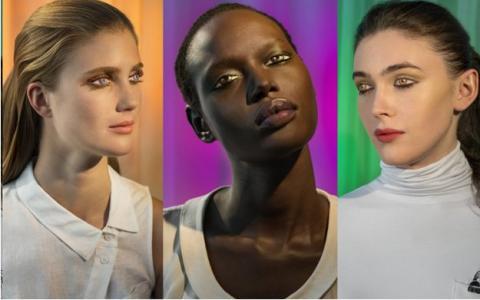‘How We See’: Photographer Laurie Simmons’ Mainstream Embrace

A recent talk between Laurie Simmons and art critic/author Lynne Tillman, held at the Jewish Museum on the Upper East Side, provided an adequate summation of Simmons’ oeuvre and also shed some light on her current show on display at the museum, How We See. What was also achieved, however, was the realization that while Simmons is undeniably a major force in the photography world, this show lacks the depth and social awareness that she is known for.
Simmons made a name for herself in the ‘70s and ‘80s by constructing dollhouse rooms and photographing them. They were a subversive reflection on the Marxist notion of the fetishizing commodity and were done through a feminist lens. She was not interested so much with creating a narrative in her photographs, though her subject matter may have reflected otherwise. Rather, she refers to the early works as “doll still life work” and they became as such after she stared at the created spaces until they became void of meaning and abstract to her. The association with still life is troublesome, however, as historically they are subtle indicators of place, time, and wealth, thereby creating a kind of narrative, albeit a more stagnant one. Though she may have intended to create a unified collage of clichés and pop culture motifs as an ironic commentary, for many viewers her photographs did tell a story.
The first time she photographed objects in human scale was for The Love Doll. She used Japanese sex dolls to again explore the idea of trying to construct identity within dominant cultural models. She never used mannequins prior to that, as she pointed out in the talk, because they were “too static” (almost humorous given her quest to move away from narrative). Once she began photographing in this scale though, she never went back to miniatures. And her work from this series has been recognized by the Observer as “[humanizing] these creations of lust” and in keeping with her “feminine perspective from within America’s patriarchy.” And she did so to maintain the idea that all identities are also constructs, and did this without coming off cold by using these sexual objects that were a happy medium between her dolls and real women.

And therein lies the problem with her current series How We See: its taciturnity. It’s another first for Simmons, this time using live models that have been heavily made up. And, though their eyes are closed, their lids are painted to look like eyes thereby toying with our perception of beauty by transforming these women into surreal versions of themselves. When asked by an audience member at the Jewish Museum why she used professional models, she said she appreciated their comfort in front of the lens, and “they somehow become transcendent.” Simmons wants to turn conventions of beauty on their head but she is too reliant on them in this particular collection. It’s why her message falls flat and why her previous collections using dolls proved more successful.
Though sometimes it’s best to avoid personal biography when analyzing the particular choices of an artist, it seems that in certain ways Simmons’ earlier work is informed by her childhood and her recent work by her openness to the mainstream as she becomes more comfortable in her world. At the talk she mentioned two aspects of her childhood that resonate in her photographs: how she believed interior spaces reflected our minds’ interior, and how her mother believed that it didn’t matter what was underneath so long as you looked perfect.
And her dollhouse photographs are reflective of psychology and its relationship to the created Self, both interior and exterior. At the time of those creations, she resisted descriptors like surreal, humor, or fantasy but as her career went on, she discussed her acceptance with pretty much any description of her work so long as it remains engaging.

And it’s important to note that she has come into the mainstream more due to her daughter Lena Dunham’s fame. They’ve even collaborated on a movie together, Tiny Furniture, where Simmons plays a character very much created in her own image. And what’s also indicative of this shift to the mainstream is her emphasis on advertising in How We See. She had fashion designer Rachel Antonoff style the women, and it bears repeating that they are professional fashion models. It’s not to say that these photographs aren’t visually appealing or astounding – they are large, bright, and commanding. However, in comparison to her former pieces, while Laurie Simmons may have tried to be ironic about standards of beauty by using these subjects and collaborators, the end result is simply a series of superficially beautiful pictures from a photographic icon.

Author Bio:
Sabeena Khosla is a contributing writer at Highbrow Magazine.




























































































































































































































































































































